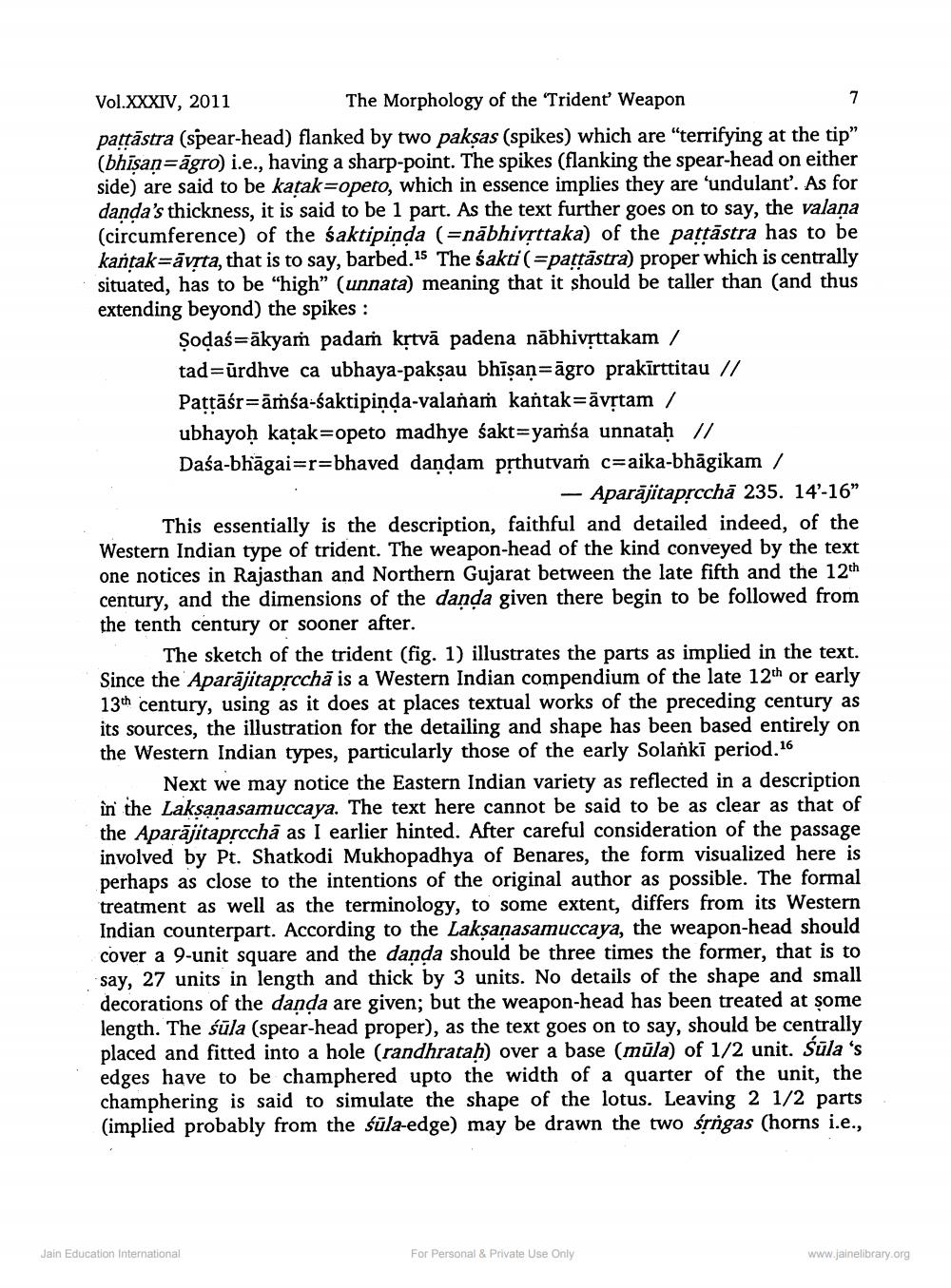________________
Vol.XXXIV, 2011
The Morphology of the 'Trident Weapon pattāstra (spear-head) flanked by two paksas (spikes) which are "terrifying at the tip” (bhişan=āgro) i.e., having a sharp-point. The spikes (flanking the spear-head on either side) are said to be katak=opeto, which in essence implies they are 'undulant'. As for danda's thickness, it is said to be 1 part. As the text further goes on to say, the valana (circumference) of the saktipinda (=nābhivrttaka) of the pattāstra has to be kantakrāvrta, that is to say, barbed. 15 The sakti (=pattāstra) proper which is centrally situated, has to be "high" (unnata) meaning that it should be taller than (and thus extending beyond) the spikes :
Sodaś=äkyam padam kľtvā padena nābhivșttakam / tad=ūrdhve ca ubhaya-paksau bhīsan=āgro prakīrttitau // Pattāśr=āmśa-saktipinda-valanam kantak=āvstam/ ubhayoḥ kațak=opeto madhye śakt=yaṁśa unnataḥ // Daśa-bhāgai=r=bhaved dandam prthutvaṁ c=aika-bhāgikam /
- Aparājitaprcchā 235. 14-16" This essentially is the description, faithful and detailed indeed, of the Western Indian type of trident. The weapon-head of the kind conveyed by the text one notices in Rajasthan and Northern Gujarat between the late fifth and the 12th century, and the dimensions of the danda given there begin to be followed from the tenth century or sooner after.
The sketch of the trident (fig. 1) illustrates the parts as implied in the text. Since the Aparājitaprccha is a Western Indian compendium of the late 12th or early 13th century, using as it does at places textual works of the preceding century as its sources, the illustration for the detailing and shape has been based entirely on the Western Indian types, particularly those of the early Solanki period. 16
Next we may notice the Eastern Indian variety as reflected in a description in the Laksanasamuccaya. The text here cannot be said to be as clear as that of the Aparājitaprcchá as I earlier hinted. After careful consideration of the passage involved by Pt. Shatkodi Mukhopadhya of Benares, the form visualized here is perhaps as close to the intentions of the original author as possible. The formal treatment as well as the terminology, to some extent, differs from its Western Indian counterpart. According to the Laksanasamuccaya, the weapon-head should cover a 9-unit square and the danda should be three times the former, that is to say, 27 units in length and thick by 3 units. No details of the shape and small decorations of the danda are given; but the weapon-head has been treated at some length. The śüla (spear-head proper), as the text goes on to say, should be centrally placed and fitted into a hole (randhratah) over a base (mūla) of 1/2 unit. Śūla's edges have to be champhered upto the width of a quarter of the unit, the champhering is said to simulate the shape of the lotus. Leaving 2 1/2 parts (implied probably from the śūla-edge) may be drawn the two śrrigas (horns i.e.,
Jain Education International
For Personal & Private Use Only
www.jainelibrary.org




